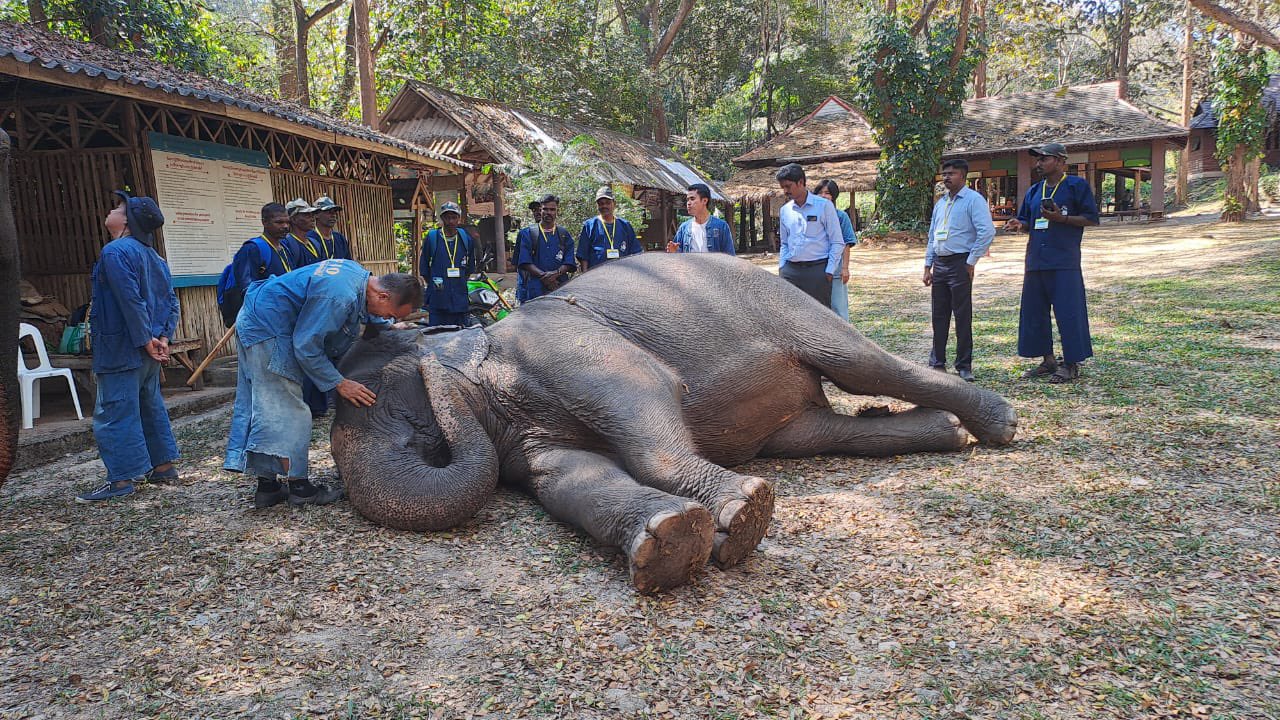The decision was taken to provide them with a modern and scientific approach to handling and treating captive elephants.

Mahouts from Tamil Nadu getting trained at TECC in Thailand. (Supplied)
A total of 13 tribal mahouts (elephant riders and trainers) and cavadis (assistants to the mahouts) — attached to the Tamil Nadu Forest Department from the Mudumalai and Anamalai elephant camps — are in Thailand.
Why, you wonder? To receive training at the Thailand Elephant Conservation Centre (TECC)!
At least 63 elephants are taken care of by 37 mahouts and 28 cavadis at the elephant camps at Theppakadu in the Mudumalai Tiger Reserve and Kozhikamuthi at the Anamalai Tiger Reserve.
So proud to see our Mahaouts & Cavadis from Mudumalai & Anamalai elephant camps going to Thailand(a first time flight experience ever for all 13 of them) for training at Thailand Elephant Conservation Centre. Looking cool they are indeed making a journey of a lifetime #TNForest pic.twitter.com/wrdprgvcPo
— Supriya Sahu IAS (@supriyasahuias) February 5, 2023
It was on 21 November, 2022, that the Tamil Nadu Forest Department issued a government order (GO) allowing the training of mahouts and their assistants — deputed in the government-run captive centres for elephants — at the TECC.
Established in 1993, the Thai establishment is a centre for research and a pioneer in treating sick elephants.
It takes care of more than 50 Asian elephants and also provides mahout training.
The decision was taken as these mahouts are usually from tribal communities and have been training elephants based on their traditional knowledge.
In order to provide them with a modern scientific approach to handling and treating captive elephants, the Forest Department selected 13 mahouts for training in the first phase.
On 5 February, the group of 13 mahouts and their cavadis left for Thailand, accompanied by the deputy director of the Mudumalai Tiger Reserve and a forest ranger from the Anamalai elephant camp.
The mahouts were taken to Chennai and from there they flew to Thailand. This was the first flight experience ever for all the 13 tribal mahouts and cavadis.
A sum of ₹50 lakh has been allotted for the entire training and travel expenses, drawn from the Anamalai and Mudumalai Tiger Reserve Foundation funds, divided into ₹23.60 lakh and ₹26.40 lakh, respectively.
Update on training of our Mahouts and Cavadis at Thailand.Visit to the elephant resting areas, interpretation centre and the museum.discussions and presentations. #TNForest pic.twitter.com/gYVHBPpLFa
— Supriya Sahu IAS (@supriyasahuias) February 6, 2023
Speaking to South First, Supriya Sahu, Additional Chief Secretary, Environment — Climate Change and Forest Department, said, “Conservation evolves every day. Our mahouts know everything about elephants through rich traditional knowledge. It transforms them through generations. I went to some of these elephant camps and these mahouts from tribal communities are much more committed and dedicated to elephant conservation.”
She added: “The basic idea is to build their knowledge, in terms of new scientific approaches to elephant conservation.”
Speaking about the techniques taught at the Thai training camp, Sahu said, “Our mahouts will learn how to understand the psychology of elephants, how to treat the elephants, how to look at the medical aspects of the elephants and identify the diseases at early stages, and how to look for ailments and examine the elephant, scientifically.”
So, will there be more such training sessions abroad for India’s mahouts?
Sahu replied, “Once these 13 mahouts return from training, we will get their feedback and then decide whether to send another batch of mahouts.”
She also said that the possibility of giving such training to the mahouts who look after temple elephants would be considered in the future.
A total of 37 mahouts (22 in Mudumalai and 15 in Anamalai) and 28 cavadis (12 in Mudumalai and 16 in Anamalai) are on the direct payroll of the government.
Apart from them, 56 mahouts are engaged on a contract basis.
The life of a mahout is not easy — and could be dangerous.
In neighbouring Kerala, a celebrated elephant, Thechikottukavu Ramachandran, who is loved and hated in equal measure, has a dubious legacy: He has killed 13 people, six among them his own mahouts, apart from three other captive elephants.

Apr 25, 2024

Apr 25, 2024

Apr 25, 2024

Apr 25, 2024

Apr 24, 2024

Apr 23, 2024